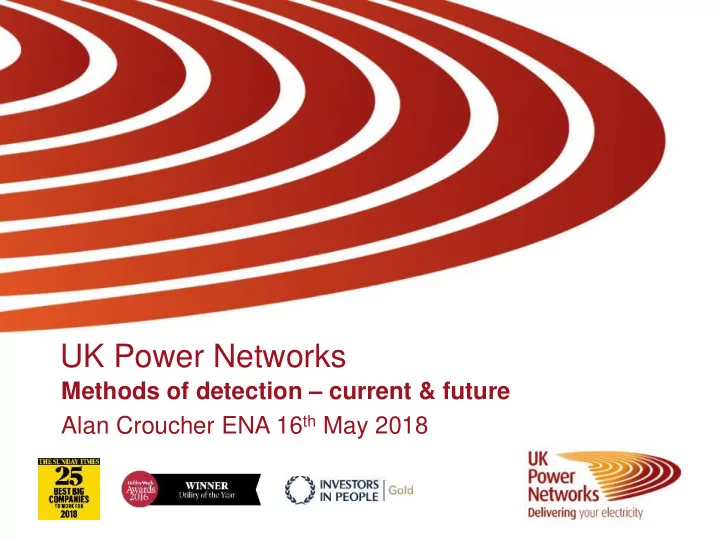

UK Power Networks Methods of detection – current & future Alan Croucher ENA 16 th May 2018
So how do we find cable leaks? • Currently we have 3 primary leak location methods: – Cable Freeze – Capenhurst hydraulic method – Perfluorocarbon Tracer Leak Location (PFT) • Future (in development) – Smart Heat – Active pressure control
Cable Freezes • Cable freezes have been the mainstay for leak detection for many years. • This method freezes the fluid in the cable, and by monitoring the pressure drop (or flow) at each end of the circuit, an indication can be given of the leak direction. • There are limitations to this method – The cable needs to be de-energised – Unable to detect smaller leaks – Multiple excavations required – Disruption to the public and highways – Cost – Time – Leaks can stop when a cable is taken out of service – Cable freezes can lead to future leaks
Capenhurst Hydraulic Method • This leak location technology measures the flow of fluid through the cable, and by knowing the length and hydraulic resistance of the cable an estimation of the leak position can be found. • The limitations with this method are : – The cable needs to be de-energised – Unable to find smaller leaks – Accuracy of the results – Cannot find multiple leaks on one cable – Again, leaks can stop when a cable is taken out of service
PFT Leak Location System • PFT Leak Location system operates by detecting a Perfluorocarbon tracer that evaporates, when it leaks from a suitable tagged leaking cable section at the point of leak. • The limitations of this method are: – The Cable needs to be “tagged” with a PFT, which then needs to reach the point of leak. • Some of the many benefits of this method are: – The circuit does not need to be de- energised for the location to be undertaken. – Small leaks are detectable (<40L/m).
Tagging Methods: “Regular Pumping” This method of tagging only requires that the cable fluid pumped into the circuit to replenish fluid lost to the leak is tagged. The limitation of this method is that it can take some time for the tagged fluid to reach the leak, and the leak to become detectable, for example: If the circuit is leaking 100L per week and is 2km long, and it contains 1000L of “free” fluid, it could potentially take 10 weeks for the cable to be fully tagged
Future developments Smart Heat
Smart Heat • For this method, rather than freezing the cable, we heat it • A heater jacket is placed around the cable, as the fluid moves in the direction of the leak the heat is drawn in that direction. • This method is limited by the leak rate of the cable which needs to be above 400 litres per month to work.
132kV 3 Core leaking ~200L/week
Future developments Active Pressure Control
Active Pressure Control • Fluid Filled Cables operate over a varying pressure range depending on where the cables are installed. • Each cable has a operating pressure range and a lowest possible operating pressure (Alarm Pressure) • If we can operate the cables closer to this alarm pressure, leaks may be minimised and less stress put on cable sheaths and joints.
Cable Pressure Trend 365 days
Porous Lead Sheath
Active Pressure Control Unit
APCU Pressure Trend
APCU Pressure Trend
Thank you
Recommend
More recommend